Bart Deplancke
@bartdeplancke.bsky.social
Professor in Systems Biology & Genetics @EPFL, opinions my own; Single Cell Omics / Gene Regulation / Transcription Factor / Stem Cells / Regulatory Variation / ML / Imaging / Adipose Biology / Microfluidics
https://www.epfl.ch/labs/deplanckelab
https://www.epfl.ch/labs/deplanckelab
🧵1/ Excited to share our new paper introducing a new #singlecell assay: scTF-seq, a high-throughput single-cell approach to explore how transcription factor (TF) dose shapes cell identity and reprogramming outcomes. 🔗 www.nature.com/articles/s41... Big congrats to the entire team @EPFL & @SIAT_China

Dissecting the impact of transcription factor dose on cell reprogramming heterogeneity using scTF-seq - Nature Genetics
This study introduces single-cell transcription factor (TF) sequencing, a single-cell barcoded and doxycycline-inducible TF overexpression approach that reveals dose-sensitive functional classes of TFs and cellular heterogeneity by mapping TF dose-dependent transcriptomic changes during the reprogramming of mouse embryonic multipotent stromal cells.
www.nature.com
October 6, 2025 at 6:57 AM
🧵1/ Excited to share our new paper introducing a new #singlecell assay: scTF-seq, a high-throughput single-cell approach to explore how transcription factor (TF) dose shapes cell identity and reprogramming outcomes. 🔗 www.nature.com/articles/s41... Big congrats to the entire team @EPFL & @SIAT_China
Outstanding Faculty opportunity in the broad area of 'life sciences engineering' @EPFL School of Life Sciences, open to both junior and senior researchers. We may prefer metabolism-centric applications but remain open to outstanding applications across domains:
www.epfl.ch/about/workin...
www.epfl.ch/about/workin...

Faculty Position in Life Science Engineering
The School of Life Sciences at EPFL invites applications for a faculty position in life science engineering. Appointments will be at Tenure Track Assistant Professor or at Associate Professor level. W...
www.epfl.ch
August 6, 2025 at 2:11 PM
Outstanding Faculty opportunity in the broad area of 'life sciences engineering' @EPFL School of Life Sciences, open to both junior and senior researchers. We may prefer metabolism-centric applications but remain open to outstanding applications across domains:
www.epfl.ch/about/workin...
www.epfl.ch/about/workin...
Our new review on how #microfluidics has been key for (#single-cell) #genomics & how it will remain essential to support this new era of single cell #phenomics: www.nature.com/articles/s41.... Great timing for the Microfluidics Gordon Research Conference here in Lucca! www.grc.org/physics-and-...

Engineering next-generation microfluidic technologies for single-cell phenomics - Nature Genetics
Research is moving from a gene- and protein-centric view toward a holistic understanding of cellular phenotypes. This Review discusses the technological microfluidics challenges that must be addressed...
www.nature.com
June 2, 2025 at 9:39 AM
Our new review on how #microfluidics has been key for (#single-cell) #genomics & how it will remain essential to support this new era of single cell #phenomics: www.nature.com/articles/s41.... Great timing for the Microfluidics Gordon Research Conference here in Lucca! www.grc.org/physics-and-...
🚀 study: www.cell.com/cell/fulltex... from @larsplus.bsky.social et al: via enhancer design from scratch, 3 principles emerged: 1) TF binding strength = activation 'or' repression; 2) Same motif ≠ same output in all cell states; 3) 2 activators ≠ activation - combos can repress! #geneRegulation

Design principles of cell-state-specific enhancers in hematopoiesis
Screen of minimalistic enhancers in blood progenitor cells demonstrates widespread
dual activator-repressor function of transcription factors (TFs) and enables the model-guided
design of cell-state-sp...
www.cell.com
May 12, 2025 at 9:37 AM
🚀 study: www.cell.com/cell/fulltex... from @larsplus.bsky.social et al: via enhancer design from scratch, 3 principles emerged: 1) TF binding strength = activation 'or' repression; 2) Same motif ≠ same output in all cell states; 3) 2 activators ≠ activation - combos can repress! #geneRegulation
Impressive, new snRNA-seq atlas across 8 mouse strains & tissues reveals how genetics shapes cell-type-specific gene expression. A key resource for decoding trait variation, disease mechanisms & guiding mouse model design. #Genomics #SingleCell #PrecisionMedicine. www.biorxiv.org/content/10.1...
www.biorxiv.org
May 5, 2025 at 6:21 PM
Impressive, new snRNA-seq atlas across 8 mouse strains & tissues reveals how genetics shapes cell-type-specific gene expression. A key resource for decoding trait variation, disease mechanisms & guiding mouse model design. #Genomics #SingleCell #PrecisionMedicine. www.biorxiv.org/content/10.1...
Amazing 🚀 study w/ DNA seqFISH+, enabling mapping of 100,049 genomic loci, together with the nascent transcriptome for 17,856 genes, yielding unpredented insights into subnuclear structures in single cells www.nature.com/articles/s41...

Spatial multi-omics reveals cell-type-specific nuclear compartments - Nature
A genomic barcoding scheme called two-layer DNA seqFISH+ enables the simultaneous mapping of more than 100,000 loci and has been used to identify cell-type-specific subnuclear compartments in the mous...
www.nature.com
April 13, 2025 at 2:15 PM
Amazing 🚀 study w/ DNA seqFISH+, enabling mapping of 100,049 genomic loci, together with the nascent transcriptome for 17,856 genes, yielding unpredented insights into subnuclear structures in single cells www.nature.com/articles/s41...
Great opportunity! 🎆
Postdoc opportunity in the heart of Europe! Check out the flyer below.
Join our team on an international project with Anthony Holtmaat exploring synaptic plasticity and specificity in cortical and thalamocortical circuits.
Join our team on an international project with Anthony Holtmaat exploring synaptic plasticity and specificity in cortical and thalamocortical circuits.
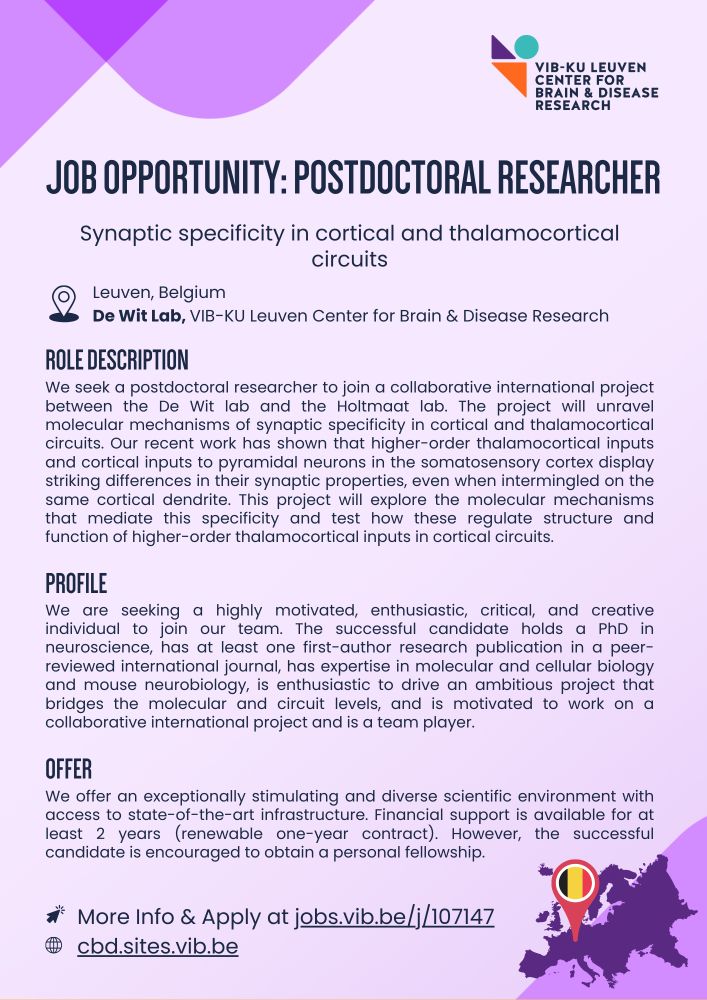
April 8, 2025 at 12:56 PM
Great opportunity! 🎆
New tool 💪 from @steinaerts.bsky.social lab: CREsted, a DL-based approach for predicting cell type-specific reg. elements, applying it to many datasets, incl. mouse cortex, human PBMCs & glioblastoma, demonstrating its ability to identify key TF binding sites: www.biorxiv.org/content/10.1...
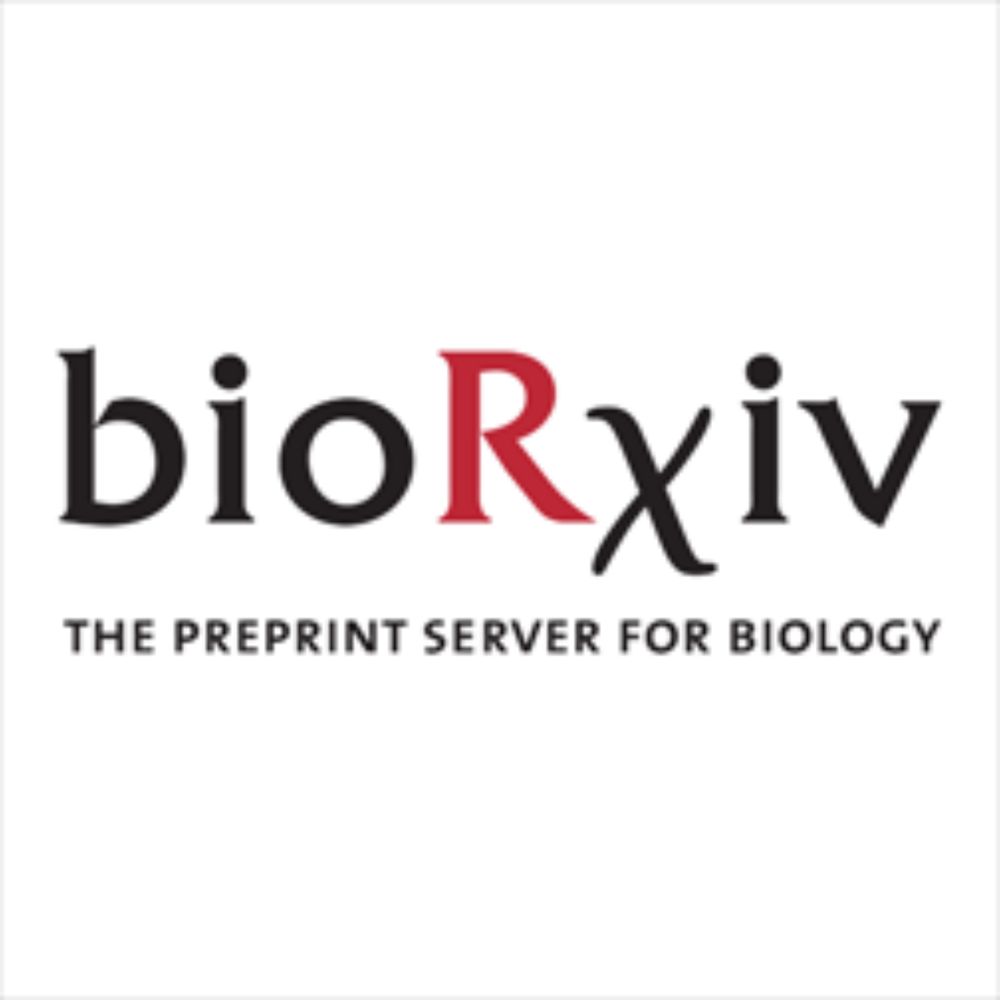
CREsted: modeling genomic and synthetic cell type-specific enhancers across tissues and species
Sequence-based deep learning models have become the state of the art for the analysis of the genomic regulatory code. Particularly for transcriptional enhancers, deep learning models excel at decipher...
www.biorxiv.org
April 6, 2025 at 6:10 PM
New tool 💪 from @steinaerts.bsky.social lab: CREsted, a DL-based approach for predicting cell type-specific reg. elements, applying it to many datasets, incl. mouse cortex, human PBMCs & glioblastoma, demonstrating its ability to identify key TF binding sites: www.biorxiv.org/content/10.1...
Reposted by Bart Deplancke
Science under attack: a growing list of statements from journals
@jama.com
jamanetwork.com/journals/jam...
@plos.org
theplosblog.plos.org/2025/02/plos...
@science.org
www.science.org/doi/10.1126/...
@nature.com
www.nature.com/articles/d41...
@embopress.org
www.embopress.org/doi/full/10....
@jama.com
jamanetwork.com/journals/jam...
@plos.org
theplosblog.plos.org/2025/02/plos...
@science.org
www.science.org/doi/10.1126/...
@nature.com
www.nature.com/articles/d41...
@embopress.org
www.embopress.org/doi/full/10....
March 19, 2025 at 12:01 PM
Science under attack: a growing list of statements from journals
@jama.com
jamanetwork.com/journals/jam...
@plos.org
theplosblog.plos.org/2025/02/plos...
@science.org
www.science.org/doi/10.1126/...
@nature.com
www.nature.com/articles/d41...
@embopress.org
www.embopress.org/doi/full/10....
@jama.com
jamanetwork.com/journals/jam...
@plos.org
theplosblog.plos.org/2025/02/plos...
@science.org
www.science.org/doi/10.1126/...
@nature.com
www.nature.com/articles/d41...
@embopress.org
www.embopress.org/doi/full/10....
#scRNAseq to the next level: www.biorxiv.org/content/bior.... Mindbogglingly 100M cell large dataset involving 50 cancer cell lines and 1,100 molecule perturbations 🤩 — an absolute feast for the data-hungry ML/AI field, poised to advance cell understanding and modeling.

Tahoe-100M: A Giga-Scale Single-Cell Perturbation Atlas for Context-Dependent Gene Function and Cellular Modeling
Building predictive models of the cell requires systematically mapping how perturbations reshape each cell’s state, function, and behavior. Here, we present Tahoe-100M , a giga-scale single-cell atlas...
www.biorxiv.org
February 28, 2025 at 2:17 PM
#scRNAseq to the next level: www.biorxiv.org/content/bior.... Mindbogglingly 100M cell large dataset involving 50 cancer cell lines and 1,100 molecule perturbations 🤩 — an absolute feast for the data-hungry ML/AI field, poised to advance cell understanding and modeling.
Really cool method 'Trace-n-seq' that allows for the molecular characterization of single neurons that innervate the pancreas and how this is altered in a cancer context at high resolution. www.nature.com/articles/s41...
Characterization of single neurons reprogrammed by pancreatic cancer - Nature
Nature - Characterization of single neurons reprogrammed by pancreatic cancer
www.nature.com
February 24, 2025 at 8:10 PM
Really cool method 'Trace-n-seq' that allows for the molecular characterization of single neurons that innervate the pancreas and how this is altered in a cancer context at high resolution. www.nature.com/articles/s41...
wow 🚀! Need to look into the details, but sounds really exciting: Seq-Scope-X --> new spatial transcriptomics & proteomics technology that achieves sub-200 nm super-resolution, surpassing the diffraction limit of optical microscopy by physically enlarging tissues. www.biorxiv.org/content/bior...
www.biorxiv.org
February 13, 2025 at 8:00 AM
wow 🚀! Need to look into the details, but sounds really exciting: Seq-Scope-X --> new spatial transcriptomics & proteomics technology that achieves sub-200 nm super-resolution, surpassing the diffraction limit of optical microscopy by physically enlarging tissues. www.biorxiv.org/content/bior...
👍
Have you finished your #PhD and are interested in exploring how #parasites cross the vasculature to colonize tissues? Do you fancy catching some #waves in the Atlantic? Or eating grilled fish by the beach?
Join us in #Lisbon at GIMM, where science meets quality of life.
@parasitesrule.bsky.social
Join us in #Lisbon at GIMM, where science meets quality of life.
@parasitesrule.bsky.social

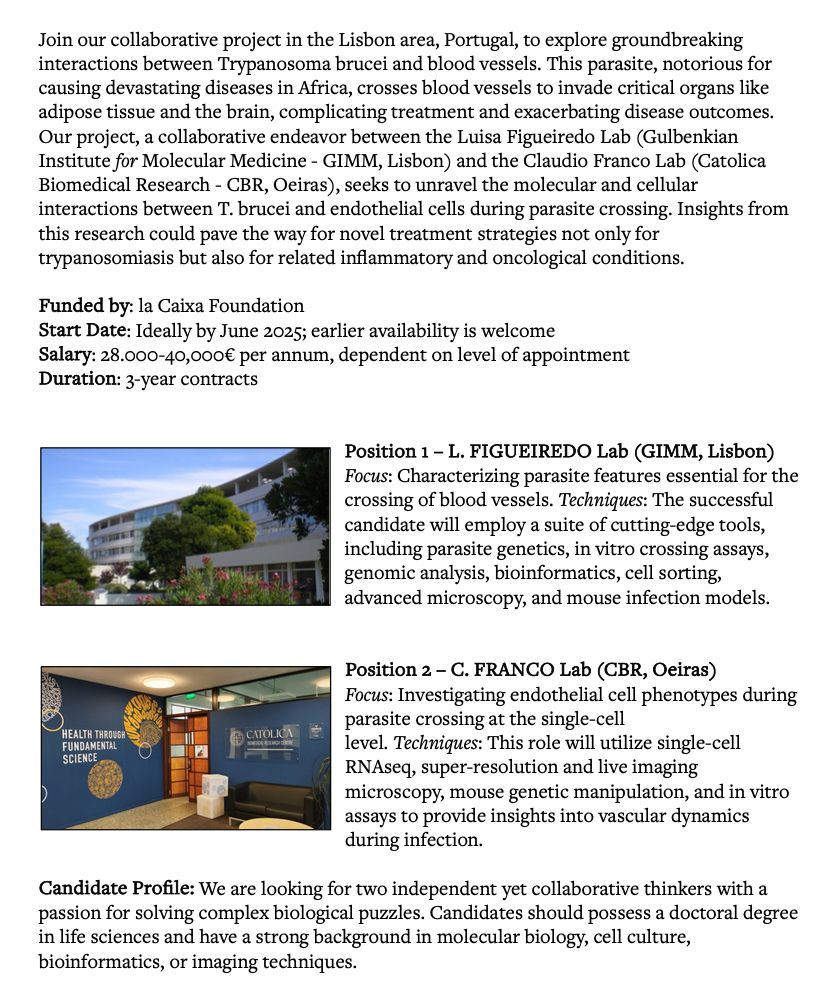
January 28, 2025 at 9:25 AM
👍
Reposted by Bart Deplancke
A new mechanism for cancer-induced immune evasion. We knew about cancer cells hijacking mitochondria. Now we learn about how their mitochondrial transfer to T cells impairs the tumor immune response.
www.nature.com/articles/s41...
www.nature.com/articles/d41...
www.nature.com/articles/s41...
www.nature.com/articles/d41...

January 22, 2025 at 4:39 PM
A new mechanism for cancer-induced immune evasion. We knew about cancer cells hijacking mitochondria. Now we learn about how their mitochondrial transfer to T cells impairs the tumor immune response.
www.nature.com/articles/s41...
www.nature.com/articles/d41...
www.nature.com/articles/s41...
www.nature.com/articles/d41...
Interesting study showing how a heart disease-linked TF, TBX5, regulates 3D chromatin independently of transcription, via structural and cohesin-regulating roles in a dose-dependent fashion www.biorxiv.org/content/10.1...
www.biorxiv.org
January 17, 2025 at 6:53 AM
Interesting study showing how a heart disease-linked TF, TBX5, regulates 3D chromatin independently of transcription, via structural and cohesin-regulating roles in a dose-dependent fashion www.biorxiv.org/content/10.1...
Cool new method (PERFF-seq) for profiling rare cell states via #scRNAseq, allowing for the isolation of rare cell populations by fluorescently labeling specific transcripts after which the respective cells are sorted, thus uncovering more phenotypic heterogeneity. www.nature.com/articles/s41...

Transcript-specific enrichment enables profiling of rare cell states via single-cell RNA sequencing - Nature Genetics
Programmable Enrichment via RNA FlowFISH by sequencing (PERFF-seq) isolates rare cells based on RNA marker transcripts for single-cell RNA sequencing profiling of complex tissues, with applicability t...
www.nature.com
January 11, 2025 at 9:41 AM
Cool new method (PERFF-seq) for profiling rare cell states via #scRNAseq, allowing for the isolation of rare cell populations by fluorescently labeling specific transcripts after which the respective cells are sorted, thus uncovering more phenotypic heterogeneity. www.nature.com/articles/s41...
Fantastic opportunity: 🚀 Calling early-career scientists! Apply for the 2025 ELISIR Scholar at EPFL. From outstanding PhD straight to group leader. Join an interdisciplinary research community to conduct independent research in any area of #lifesciences in Lausanne, CH
👉 go.epfl.ch/ELISIR
👉 go.epfl.ch/ELISIR
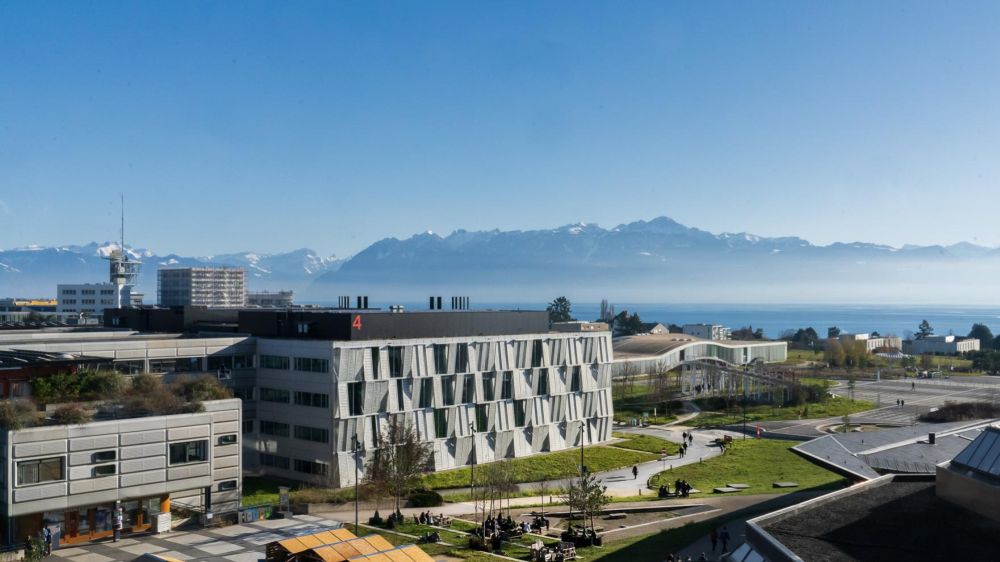
EPFL Life Sciences Early Independent Research Scholar (ELISIR)
From exceptional PhD directly to independent group leader
go.epfl.ch
January 10, 2025 at 5:03 PM
Fantastic opportunity: 🚀 Calling early-career scientists! Apply for the 2025 ELISIR Scholar at EPFL. From outstanding PhD straight to group leader. Join an interdisciplinary research community to conduct independent research in any area of #lifesciences in Lausanne, CH
👉 go.epfl.ch/ELISIR
👉 go.epfl.ch/ELISIR
Interesting study showing that Bicoid clusters in fly embryos preserve nuclear concentration info, guiding gene expression despite non-linear LLPS models. These clusters also act as high-fidelity sensors, key for fast, precise transcriptional regulation. www.science.org/doi/10.1126/...

Transcription factor clusters as information transfer agents
Live imaging shows that regulatory protein clusters may aid fast and precise delivery of transcriptional information to gene loci.
www.science.org
January 6, 2025 at 4:01 PM
Interesting study showing that Bicoid clusters in fly embryos preserve nuclear concentration info, guiding gene expression despite non-linear LLPS models. These clusters also act as high-fidelity sensors, key for fast, precise transcriptional regulation. www.science.org/doi/10.1126/...
Superb work by Wouter @Zouters & @OlgaPushkarev developing ChromatinHD, two scale-adaptive #machinelearning models & interpretation tools that use #scRNAseq + #scATACseq data to better understand how chromatin accessibility relates to gene expression doi.org/10.1038/s414...
Happy 2025 everyone 🎆 !
Happy 2025 everyone 🎆 !

ChromatinHD connects single-cell DNA accessibility and conformation to gene expression through scale-adaptive machine learning - Nature Communications
Functional chromatin changes occur at different scales. Here, the authors introduce ChromatinHD, a method that characterises differential and predictive chromatin accessibility changes in a scale-adap...
doi.org
January 6, 2025 at 2:05 PM
Superb work by Wouter @Zouters & @OlgaPushkarev developing ChromatinHD, two scale-adaptive #machinelearning models & interpretation tools that use #scRNAseq + #scATACseq data to better understand how chromatin accessibility relates to gene expression doi.org/10.1038/s414...
Happy 2025 everyone 🎆 !
Happy 2025 everyone 🎆 !
Cool framework to systematically compare & evaluate methods that integrate scRNA+ATAC-seq data to infer GRNs, highlighting limitations & variability in performance across different tasks and clear challenge to capture causal relationships from perturbation assays www.biorxiv.org/content/bior...
www.biorxiv.org
December 24, 2024 at 9:18 AM
Cool framework to systematically compare & evaluate methods that integrate scRNA+ATAC-seq data to infer GRNs, highlighting limitations & variability in performance across different tasks and clear challenge to capture causal relationships from perturbation assays www.biorxiv.org/content/bior...
Interesting study on the use of #scRNA-seq data for protein level prediction. It highlights the limitations of mRNA as a predictor of protein expression and the effectiveness of #machine-learning models in improving protein abundance estimations. www.biorxiv.org/content/10.1...

Machine Learning Predictions Surpass Individual mRNAs as a Proxy of Single-cell Protein Expression
Expansive repositories of single-cell RNA-seq data are now available for large-scale transcriptomics analysis at single-cell resolution. However, proteomics data are relatively limited in scale and se...
www.biorxiv.org
December 20, 2024 at 7:45 AM
Interesting study on the use of #scRNA-seq data for protein level prediction. It highlights the limitations of mRNA as a predictor of protein expression and the effectiveness of #machine-learning models in improving protein abundance estimations. www.biorxiv.org/content/10.1...
Judith's magnum opus from her postdoc in our lab: a genome-integrated massively parallel reporter assay for quantitative insights into enhancer-promoter communication, AI benchmarking, variant dissection, & promoter motif characterization. It will be the foundation of her new lab @USC, Jan 2025! 🚀
Finally out! We present EXTRA-seq, a new EXTended Reporter Assay to quantify endogenous enhancer-promoter communication at kb scale!
www.biorxiv.org/content/10.1...
A 🧵about what it can do:
#SynBio #DeepLearning #GeneRegulation
www.biorxiv.org/content/10.1...
A 🧵about what it can do:
#SynBio #DeepLearning #GeneRegulation

EXTRA-seq: a genome-integrated extended massively parallel reporter assay to quantify enhancer-promoter communication
Precise control of gene expression is essential for cellular function, but the mechanisms by which enhancers communicate with promoters to coordinate this process are not fully understood. While seque...
biorxiv.org
December 17, 2024 at 12:58 PM
Judith's magnum opus from her postdoc in our lab: a genome-integrated massively parallel reporter assay for quantitative insights into enhancer-promoter communication, AI benchmarking, variant dissection, & promoter motif characterization. It will be the foundation of her new lab @USC, Jan 2025! 🚀
Reposted by Bart Deplancke
📣 Please share: We’re hiring a tenure-track Group Leader in Multicellular Systems to explore the molecular and cellular mechanisms driving the formation, maintenance, or destabilization of tissues, organs and organisms. Apply at: www.fmi.ch/education-ca...
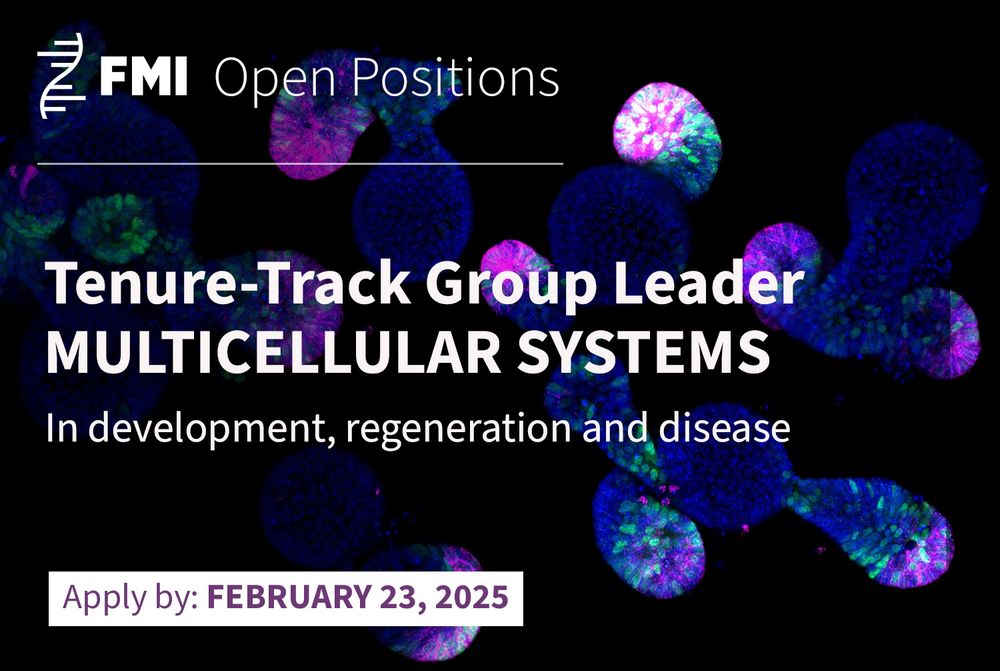
December 16, 2024 at 11:50 AM
📣 Please share: We’re hiring a tenure-track Group Leader in Multicellular Systems to explore the molecular and cellular mechanisms driving the formation, maintenance, or destabilization of tissues, organs and organisms. Apply at: www.fmi.ch/education-ca...
Reposted by Bart Deplancke
1/7 Planning to build a single-cell atlas? Or wondering how atlases can be useful to your research? Read our guide on single-cell atlases www.nature.com/articles/s41... published in Nature Methods, by @lisasikkema.bsky.social, @khrovatin.bsky.social, Malte Luecken, @fabiantheis.bsky.social et al.

December 13, 2024 at 10:33 AM
1/7 Planning to build a single-cell atlas? Or wondering how atlases can be useful to your research? Read our guide on single-cell atlases www.nature.com/articles/s41... published in Nature Methods, by @lisasikkema.bsky.social, @khrovatin.bsky.social, Malte Luecken, @fabiantheis.bsky.social et al.
Major milestone: Tabula Sapiens 2.0 maps tissue composition & TF expression in 175 cell types, identifying 745 ubiquitous & 890 cell type-specific TFs (many still uncharacterized -> #Codebook) w/ roles in tissue homeostasis, stress response & metabolism. #SingleCell www.biorxiv.org/content/10.1...

Tabula Sapiens reveals transcription factor expression, senescence effects, and sex-specific features in cell types from 28 human organs and tissues
The Tabula Sapiens is a reference human cell atlas containing single cell transcriptomic data from more than two dozen organs and tissues. Here we report Tabula Sapiens 2.0 which includes data from ni...
www.biorxiv.org
December 8, 2024 at 8:55 AM
Major milestone: Tabula Sapiens 2.0 maps tissue composition & TF expression in 175 cell types, identifying 745 ubiquitous & 890 cell type-specific TFs (many still uncharacterized -> #Codebook) w/ roles in tissue homeostasis, stress response & metabolism. #SingleCell www.biorxiv.org/content/10.1...

